Friday, December 7
• Neptune is very close to Mars. This evening, as seen from North America, Neptune appears only 1/4° from Mars — which is 1,400 times brighter, a much more radical difference than is shown above! With your scope, look for 8th-magnitude Neptune 1/4° to Mars's southwest, then use high power to check that it's non-stellar. See Mars and Neptune Have a Close Shave.
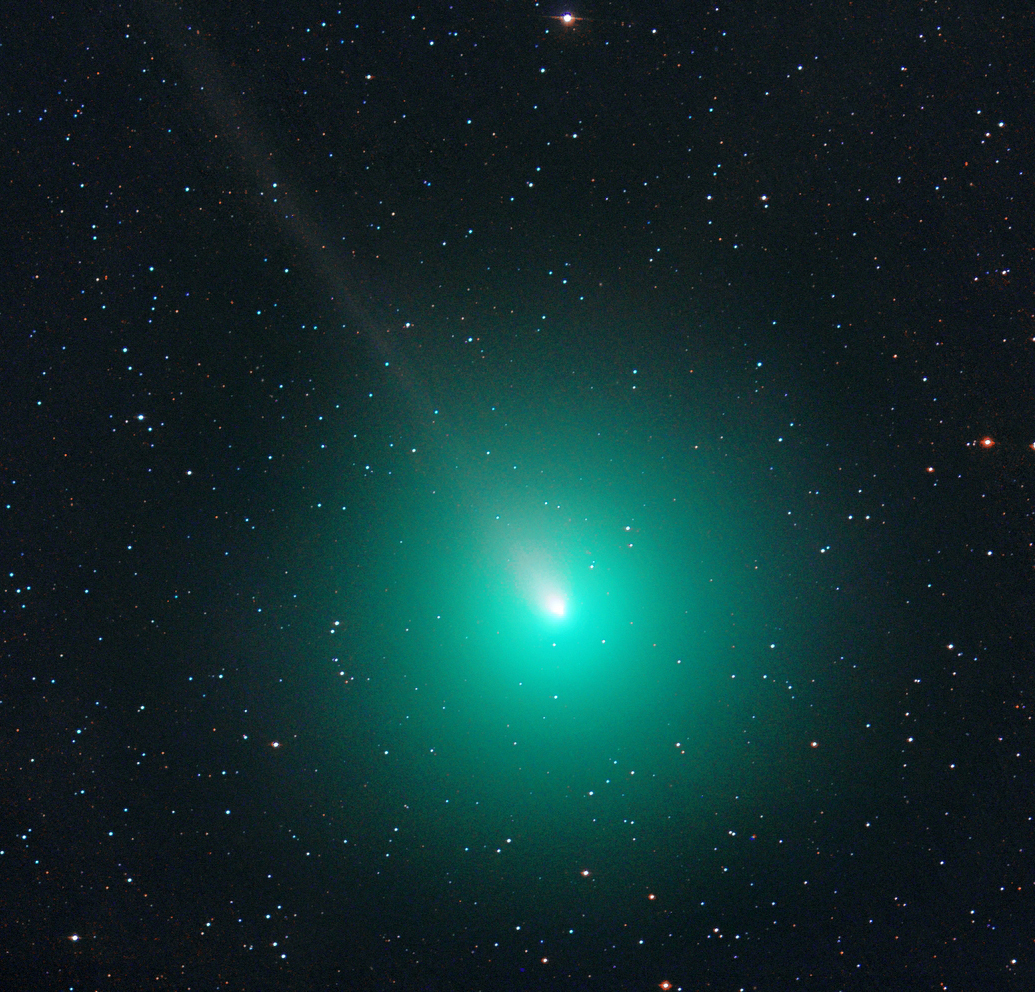
• Comet Wirtanen may or may not come within binocular, or even small-telescope, view as it passes unusually close by Earth for the next two weeks. Try for it this week before moonlight becomes a problem. The comet will appear very large (perhaps ½° across) but ghostly dim and diffuse, perhaps much dimmer than your light pollution. See Comet 46P/Wirtanen Approaches Earth, and as Joe Rao warns there, keep your expectations low.
• Earliest sunset of the year (if you're near latitude 40° north). By the time of the solstice and longest night on December 21st, the Sun actually sets 3 minutes later than it does this week. (And, the latest sunrise doesn't come until January 4th. These discrepancies arise from the tilt of Earth's axis and the ellipticity of Earth's orbit.)
• New Moon (exact at 2:20 a.m. on the morning of Dec. 7 EST).
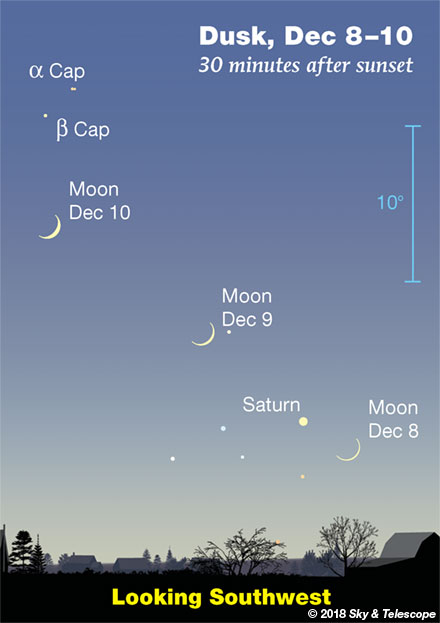
Saturday, December 8
• As twilight fades, bid farewell to Saturn using the thin crescent Moon very low in the southwest as your guide, as shown here. Binoculars may help.
• Orion comes into good view low in the east after dinnertime now. That means Gemini is also coming up to its left (for the world's mid-northern latitudes). The head stars of the Gemini twins, Castor and Pollux, are at the left end of the Gemini constellation — one over the other, with Castor on top.
High above Orion is Aldebaran, at one tip of the V-shaped asterism made by the brightest stars of the Hyades cluster.
And high above Aldebaran and the Hyades are the Pleiades, a smaller but brighter cluster. The Pleiades are about as big as your fingertip at arm's length. The Hyades are 150 light-years distant; the Pleiades are about 440, which is why the Pleiades appear smaller.
Far to their left shines bright Capella, magnitude zero.
Sunday, December 9
• Now the crescent Moon is easy in twilight. If it were a bow, it would be aiming an arrow down at Saturn, as shown above.
Monday, December 10
• Again the twilight crescent Moon is a bow aiming its arrow at Saturn, but now from farther away (as shown above).
• As soon as twilight ends, look above the Moon for Alpha and Beta Capricorni. Both are binocular double stars.
Tuesday, December 11
• Now you'll find Alpha and Beta Capricorni to the right of the Moon at nightfall.
• The Summer Triangle is sinking lower in the west, and Altair is the first of its stars to go (for mid-northern observers). Start by spotting bright, zero-magnitude Vega in the northwest right after dark. The brightest star above Vega is Deneb. Altair, the Triangle's third star, is farther to Vega's left or lower left. How late into the night, and into the advancing season, can you keep Altair in view?
Wednesday, December 12
• The thick crescent Moon forms a roughly equilateral triangle, 20° or more on a side, with Mars to its upper left and Fomalhaut to its lower left.
Thursday, December 13
• The Mars-Moon-Fomalhaut triangle has narrowed since yesterday as the Moon moves eastward along its orbit.
• The Geminid meteor shower should be at its peak late tonight! In early evening the meteors will be few, but those that do appear will be Earth-grazers skimming far across the top of the atmosphere. As the hours pass and the shower's radiant (near Castor in Gemini) rises higher in the east, the meteors will become shorter and more numerous — the most so from midnight to dawn.
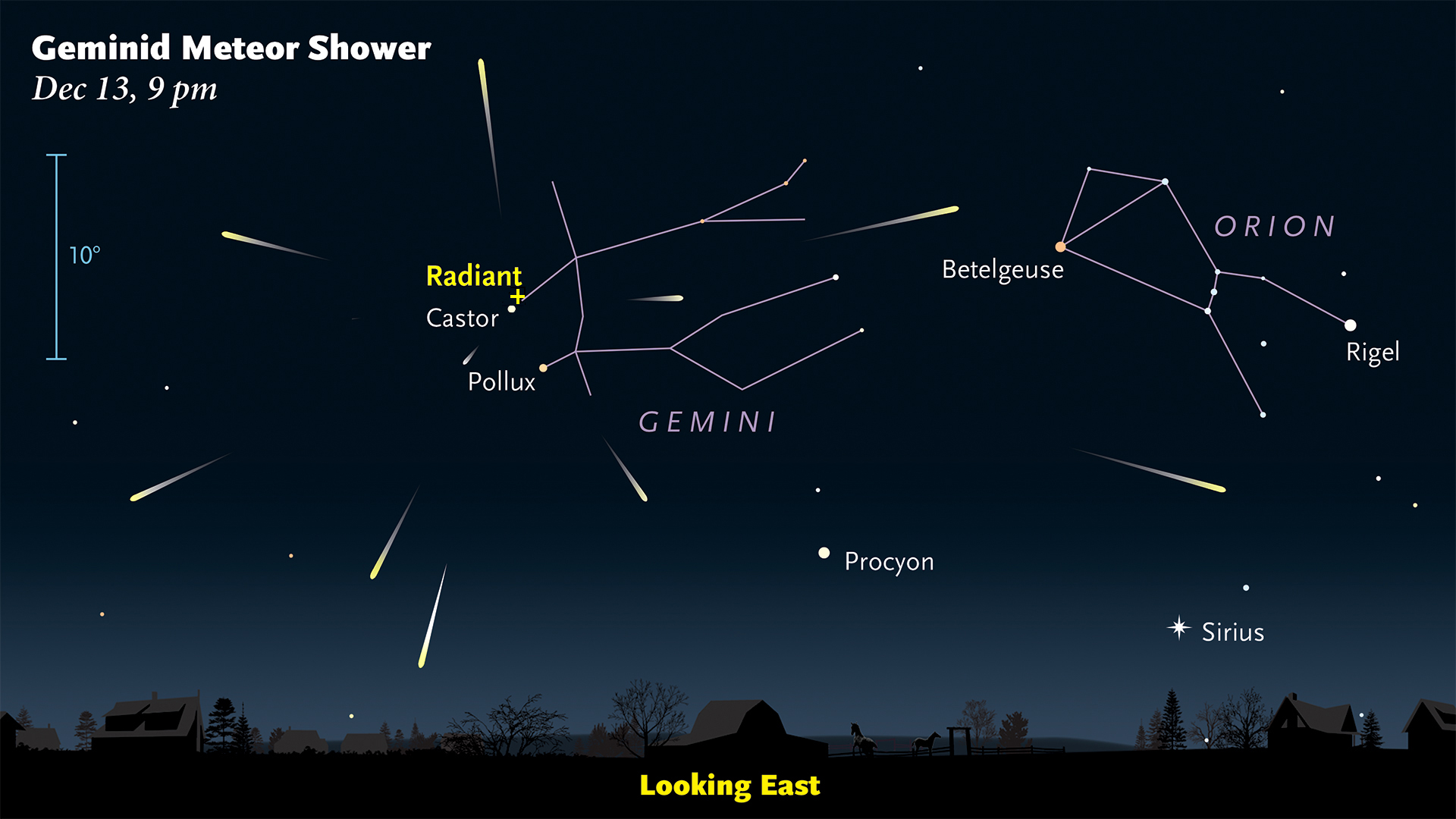
Layer up even more warmly than you imagine you'll need; think radiational cooling! Find a dark open spot with no local lights to get in your eyes, lie back in a reclining lawn chair, and gaze up into the stars. Be patient. As your eyes adapt to the dark, you may see a Geminid every minute or two on average as night grows late.
Friday, December 14
• In early evening, Mars shines above the Moon. Mars is about twice as big as the Moon in physical diameter, but it's currently 425 times farther away.
Look far below them for Fomalhaut. At a distance of 25 light-years, Fomalhaut is 1.4 million times farther away than Mars.
Saturday, December 15
• Now, in early evening, Mars shines to the right of the first-quarter Moon. Look above them for the Great Square of Pegasus.
As evening grows late, Mars tilts down to the Moon's lower right.
________________________
Want to become a better astronomer? Learn your way around the constellations! They're the key to locating everything fainter and deeper to hunt with binoculars or a telescope.
This is an outdoor nature hobby. For an easy-to-use constellation guide covering the whole evening sky, use the big monthly map in the center of each issue of Sky & Telescope, the essential guide to astronomy.

Once you get a telescope, to put it to good use you'll need a detailed, large-scale sky atlas (set of charts). The basic standard is the Pocket Sky Atlas (in either the original or Jumbo Edition), which shows stars to magnitude 7.6.
Next up is the larger and deeper Sky Atlas 2000.0, plotting stars to magnitude 8.5; nearly three times as many. The next up, once you know your way around, are the even larger Interstellarum atlas (stars to magnitude 9.5) and Uranometria 2000.0 (stars to magnitude 9.75). And read how to use sky charts with a telescope.
You'll also want a good deep-sky guidebook, such as Sue French's Deep-Sky Wonders collection (which includes its own charts), Sky Atlas 2000.0 Companion by Strong and Sinnott, or the bigger Night Sky Observer's Guide by Kepple and Sanner.
Can a computerized telescope replace charts? Not for beginners, I don't think, and not on mounts and tripods that are less than top-quality mechanically (meaning heavy and expensive). And as Terence Dickinson and Alan Dyer say in their Backyard Astronomer's Guide, "A full appreciation of the universe cannot come without developing the skills to find things in the sky and understanding how the sky works. This knowledge comes only by spending time under the stars with star maps in hand."
This Week's Planet Roundup
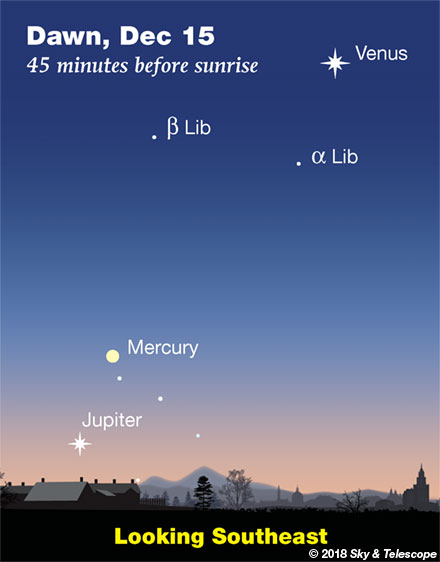
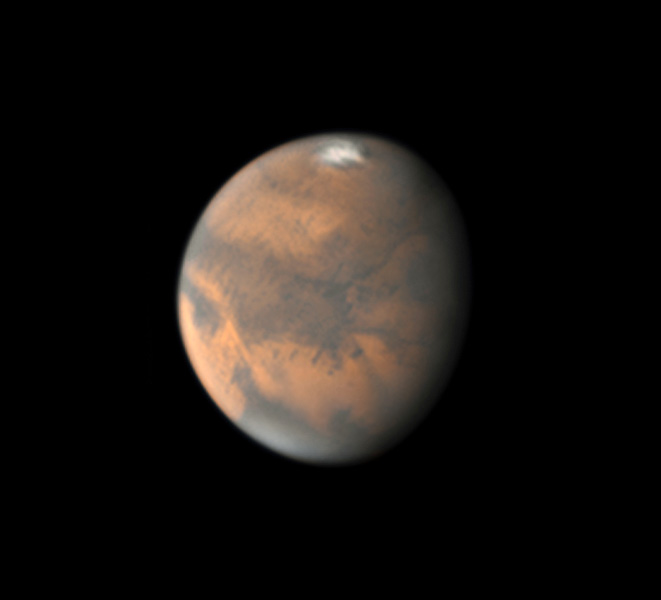
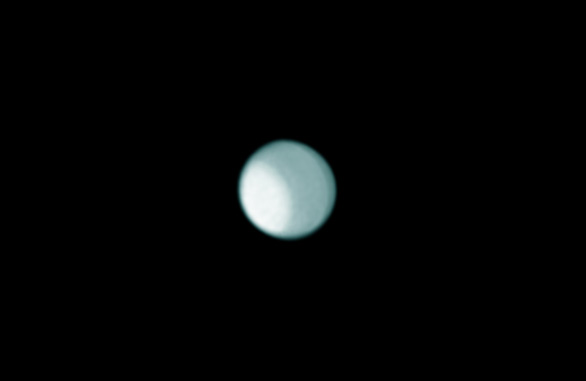
Mercury is beginning its best dawn apparition of 2018. Look for it low above the southeast horizon, 24° lower left of Venus, about 60 to 45 minutes before sunrise. Mercury brightens from magnitude 0.0 to –0.4 this week.
By the morning of Friday Dec. 14, can you pick up Jupiter emerging 7° below or lower left of Mercury? Binoculars help!
Venus (magnitude –4.8, in Virgo) rises as an eerie "UFO" above the east-southeast horizon a good two hours before the first light of dawn. As dawn arrives, Venus is the brilliant "Morning Star" dominating the southeast. Look for Spica, much fainter, increasingly far to its upper right.
In a telescope Venus is a shrinking and thickening crescent, waxing from 31% to 35% sunlit this week. For the sharpest telescopic views, follow it up higher all the way past sunrise and into the blue sky of day.
Mars (magnitude +0.1, in Aquarius) still shines highest in the south at nightfall and sets by midnight. In a telescope it's gibbous and quite small: 9 arcseconds from pole to pole. For a Mars map that displays which side is facing Earth at your time and date, use our Mars Profiler.
Jupiter (magnitude –1.7) is just beginning to emerge from solar conjunction very low in the glow of sunrise. By the morning of Saturday Dec. 15, can you pick it up 6° below Mercury as shown here? Binoculars may help.
Saturn (magnitude +0.6, in Sagittarius) sinks from sight very low in the southwest in twilight, as shown at the top of this page.
Uranus, near the Aries-Pisces border, is pretty easy to see in binoculars at magnitude 5.7 — with a good finder chart, if you know the constellations well enough to see where to start with the chart.
Neptune, in Aquarius, is more difficult at magnitude 7.9. It's near Mars this week; see December 7 above, when they're closest. After the 7th, Neptune pulls away to Mars's lower right by about 0.7° per day.
Uranus and Neptune are both high in the southern side of the sky these evenings. Finder charts (without Mars).
______________________
All descriptions that relate to your horizon — including the words up, down, right, and left — are written for the world's mid-northern latitudes. Descriptions that also depend on longitude (mainly Moon positions) are for North America.
Eastern Standard Time (EST) is Universal Time (UT or GMT) minus 5 hours.
______________________
"The dangers of not thinking clearly are much greater now than ever before. It's not that there's something new in our way of thinking, it's that credulous and confused thinking can be much more lethal in ways it was never before."
— Carl Sagan, 1996
______________________
"Objective reality exists. Facts are often determinable. Vaccines save lives. Carbon dioxide warms the globe. Bacteria evolve to thwart antibiotics, because evolution. Science and reason are not a liberal conspiracy. They are how we determine facts. Civilization's survival depends on our ability, and willingness, to do this."
— Alan MacRobert, your Sky at a Glance editor
______________________
"Facts are stubborn things."
— John Adams, 1770
 2
2








Comments
Tom Hoffelder
December 7, 2018 at 11:39 am
Wirtanen was easily seen in 7X50 binoculars last evening from our driveway in Norway Maine. Being so close to eta Eri made it really easy to find.
You must be logged in to post a comment.
Anthony Barreiro
December 7, 2018 at 5:29 pm
We had exceptionally clear weather in San Francisco last night, December 6. I saw Comet Wirtanen when it was culminating around 10 pm PST, from the top of Bernal Hill, through image-stabilized 10x42 binoculars. The finder chart in Bob King's article showed me exactly where to look, otherwise I never would have noticed it. It was a faint and nondescript brightening that faded into the background sky without any clear boundary. Visually it wasn't terribly exciting, but just knowing I was looking at a comet gave me a thrill.
I also saw Mars and Neptune lining up, Uranus, and Juno, and everybody from Cygnus through Orion. It was a good night.
You must be logged in to post a comment.
You must be logged in to post a comment.